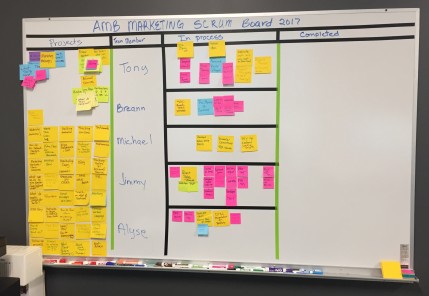
About 2 years ago I read the book SCRUM. I’m always looking for new ways to improve my architectural firm.
SCRUM is a project management process. The book’s example uses it in developing software. It’s a dynamic instead of linear process. I really like the concept and would like a way to incorporate it in my business. The projects that my firm works on are not multi-year in duration nor do they use a whole group of people full-time to accomplish them. I thought I would just need to wait for a large office relocation design project to try this method out.
Last December I was listening to the podcast Optimum Living Daily which reads blog posts so you can listen to them.
Yay! I can find a lot more time to listen than to read these days. They were reading a blog post from Kate’s Take and EOFire. She talked about how she was using SCRUM to rewrite a book and update blog posts while running her main business at the same time. This got my brain working on the possibilities to use SCRUM in my business.
One of the challenges I have as a business owner is implementation. I create ideas, my team creates ideas, and we brainstorm ideas. Somehow, I think that all these ideas are just magically going to happen, but they don’t.
I had an idea on how I could use SCRUM. This year my focus is on improving my firm’s marketing plan and implementing the strategies I have learned about.
I created my SCRUM Marketing Team and we kicked off two 4 hour brainstorming sessions at the beginning of the year. As you can see below, we used the entire board for this exercise. We transferred all of those ideas to sticky notes. Then we broke down the main ideas/projects into smaller tasks that were written on small sticky notes.
(Side note: We designed our conference room to have a white board wallcovering that runs the entire length of the room, 16 feet. This is one of the products (Walltalkers) we use when we design office spaces for our clients.)
Next, we determined how much time per week each member of the team could dedicate to working on this side project. There are 5 team members that are dedicating a total of 40 hours per week to working on the tasks, thank you Breann Nash, Tony Aligo, Jimmy Hoagland, and Michael Boykin.

Our sprints started as one week, but are now two weeks in duration. We do a review at the end of the sprint. Then assign tasks for the next sprint. We set ourselves up for some quick wins in the beginning. The items we worked on were those that were created, but not implemented and those that were almost finished.
My business partner, Michael, said we have accomplished more in the first month using SCRUM than we have completed in the past several years combined.
I’m really excited to be using this process. It’s fun for me and my team. One of my team members was working from home. She called me excited that she had one of her tasks complete. I moved it from the “In Process” column to the “Completed” column for her.
Note: As well as sharing my experiences with during the blogging process, I am also learning about passive income strategies, so some of the links in this post are affiliate links, which means I receive money if you make a purchase using the link. In this post is it the SCRUM link below.
I hope this inspires you to read SCRUM or if you have already, it helps you to see how you might use this process to build and grow your business.





When I worked at CARS the process they used to address and resolve issues was referred to as “Problem Seeking”. Bill Caudill published a book of the same name. The firm, also published a a companion to that book called “Problem Solving”! The entire firm was involved with this process.
I am excited to see that your firm is incorporating these same principles, yet under a different title.
Keep up the good work!!
LikeLike